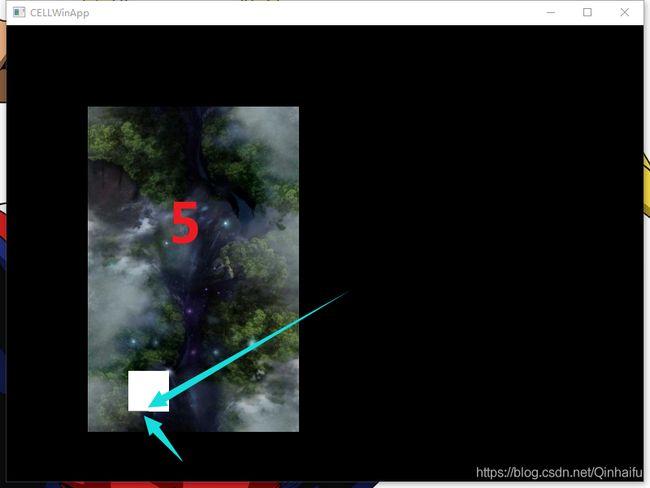glTexSubImage2D的使用详解
一、函数介绍
void glTexSubImage2D(GLenum target,
GLint level,
GLint xoffset,
GLint yoffset,
GLsizei width,
GLsizei height,
GLenum format,
GLenum type,
const GLvoid * data);
参数
target
指定活动纹理单元的目标纹理。 必须是GL_TEXTURE_2D,GL_TEXTURE_CUBE_MAP_POSITIVE_X,GL_TEXTURE_CUBE_MAP_NEGATIVE_X,GL_TEXTURE_CUBE_MAP_POSITIVE_Y,GL_TEXTURE_CUBE_MAP_NEGATIVE_Y,GL_TEXTURE_CUBE_MAP_POSITIVE_Z或GL_TEXTURE_CUBE_MAP_NEGATIVE_Z。
level
指定详细级别编号。 0级是基本图像级别。 级别n是第n个mipmap缩小图像。
xoffset
指定纹理数组中x方向的像素偏移量,x方向是指纹理坐标,即左下角为(0,0)。
yoffset
指定纹理数组中y方向的纹素偏移,y方向是指纹理坐标,即左下角为(0,0)。
width
指定纹理子图像的像素宽度。
height
指定纹理子图像的像素高度。
format
指定像素数据的格式。 接受以下符号值:GL_ALPHA,GL_RGB,GL_RGBA,GL_LUMINANCE和GL_LUMINANCE_ALPHA。
type
指定像素数据的数据类型。 接受以下符号值:GL_UNSIGNED_BYTE,GL_UNSIGNED_SHORT_5_6_5,GL_UNSIGNED_SHORT_4_4_4_4和GL_UNSIGNED_SHORT_5_5_5_1。
data
指定指向内存中图像数据的指针
注意!!!
因为纹理坐标的(0,0)点是左下角,所以我们修改纹理数据的时候是从左下角开始绘制的。
顺序先沿着X轴从左至右,再沿着Y轴从下至上,即一行一行像素的绘制。
示例代码如下:
virtual unsigned loadTexture(const char* fileName)
{
unsigned textureId = 0;
//1 获取图片格式
FREE_IMAGE_FORMAT fifmt = FreeImage_GetFileType(fileName, 0);
//2 加载图片
FIBITMAP *dib = FreeImage_Load(fifmt, fileName,0);
//3 转化为rgb 24色
dib = FreeImage_ConvertTo24Bits(dib);
//4 获取数据指针
BYTE *pixels = (BYTE*)FreeImage_GetBits(dib);
int width = FreeImage_GetWidth(dib);
int height = FreeImage_GetHeight(dib);
//windows是BGR模式
for (int i =0;i图片修改结果如下:
二、在freetype中应用的时候要注意了!!!
代码如下
int _yStart = 0;
int _xStart = 0;
char* readFile(const char* fileName, unsigned& length)
{
FILE* pFile = fopen(fileName, "rb");
if (pFile)
{
fseek(pFile, 0, SEEK_END);
length = ftell(pFile);
fseek(pFile, 0, SEEK_SET);
char*buffer = new char[length + 1];
fread(buffer, 1, length, pFile);
buffer[length] = 0;
fclose(pFile);
return buffer;
}
else
{
char buffer[1024];
sprintf_s(buffer, "read %s failed", fileName);
assert(pFile != 0 && buffer);
}
return 0;
}
void buildSystemFont(const char* font,int fontSize)
{
_uiProgram.initialize();
unsigned length = 0;
_fontBuffer = readFile(font, length);
/**
* 保存字体的大小
*/
_fontSize = fontSize;
/**
* 已经创建了字体则销毁
* 支持多次调用
*/
if (_face)
{
FT_Done_Face(FT_Face(_face));
_xStart = 0;
_yStart = 0;
memset(_character, 0, sizeof(_character));
}
/**
* 销毁字体
*/
if (_sysFontTexture != -1)
{
glDeleteTextures(1, &_sysFontTexture);
}
glGenTextures(1, &_sysFontTexture);
/**
* 使用这个纹理id,或者叫绑定(关联)
*/
glBindTexture(GL_TEXTURE_2D, _sysFontTexture);
/**
* 指定纹理的放大,缩小滤波,使用线性方式,即当图片放大的时候插值方式
*/
glTexParameteri(GL_TEXTURE_2D, GL_TEXTURE_MIN_FILTER, GL_LINEAR);
glTexParameteri(GL_TEXTURE_2D, GL_TEXTURE_MAG_FILTER, GL_LINEAR);
glTexImage2D(
GL_TEXTURE_2D,
0,
GL_ALPHA,
_textureWidth,
_textureHeight,
0,
GL_ALPHA,
GL_UNSIGNED_BYTE,
0
);
FT_Error error = FT_New_Memory_Face((FT_Library)_library,(const FT_Byte*)_fontBuffer,length,0,&(FT_Face)_face);
if (error != 0)
{
return;
}
FT_Face ftFace = (FT_Face)_face;
FT_Select_Charmap(ftFace, FT_ENCODING_UNICODE);
FT_F26Dot6 ftSize = (FT_F26Dot6)(fontSize * (1 << 6));
FT_Set_Char_Size((FT_Face)_face, ftSize, 0, 72, 72);
assert(_face != 0);
}
Character getCharacter(wchar_t ch)
{
if (_character[ch].x0 == 0 &&
_character[ch].x0 == 0 &&
_character[ch].x1 == 0 &&
_character[ch].y1 == 0
)
{
glPixelStorei(GL_UNPACK_ALIGNMENT, 1);
if (_xStart + max(_fontPixelX, _fontSize) > _textureWidth)
{
/**
* 写满一行,从新开始
*/
_xStart = 0;
/**
* y开始位置要增加
*/
_yStart += max(_fontPixelY, _fontSize);
}
FT_Load_Glyph(_face, FT_Get_Char_Index(_face, ch), FT_LOAD_DEFAULT);
FT_Glyph glyph;
FT_Get_Glyph(FT_Face(_face)->glyph, &glyph);
/**
* 根据字体的大小决定是否使用反锯齿绘制模式
* 当字体比较小的是说建议使用ft_render_mode_mono
* 当字体比较大的情况下12以上,建议使用ft_render_mode_normal模式
*/
if (!(ch >= L'0' && ch <= L'9'))
{
FT_Glyph_To_Bitmap(&glyph, ft_render_mode_normal, 0, 1);
}
else
{
FT_Glyph_To_Bitmap(&glyph, ft_render_mode_mono, 0, 1);
}
FT_BitmapGlyph bitmap_glyph = (FT_BitmapGlyph)glyph;
FT_Bitmap& bitmap = bitmap_glyph->bitmap;
FT_Bitmap ftBitmap;
FT_Bitmap_New(&ftBitmap);
if (bitmap.pixel_mode == FT_PIXEL_MODE_MONO)
{
if (FT_Bitmap_Convert((FT_Library)_library, &bitmap, &ftBitmap, 1) == 0)
{
/**
* Go through the bitmap and convert all of the nonzero values to 0xFF (white).
*/
for (unsigned char* p = ftBitmap.buffer, *endP = p + ftBitmap.width * ftBitmap.rows; p != endP; ++p)
*p ^= -*p ^ *p;
bitmap = ftBitmap;
}
}
/**
* 如果没有数据,则不写,直接过去
*/
if (bitmap.width == 0 || bitmap.rows == 0)
{
char mem[1024 * 32];
memset(mem, 0, sizeof(mem));
_character[ch].x0 = _xStart;
_character[ch].y0 = _yStart;
_character[ch].x1 = _xStart + _fontSize / 2;
_character[ch].y1 = _yStart + _fontSize - 1;
_character[ch].offsetY = _fontSize - 1;
_character[ch].offsetX = 0;
glBindTexture(GL_TEXTURE_2D, _sysFontTexture);
glTexSubImage2D(
GL_TEXTURE_2D,
0,
_xStart,
_yStart,
_fontSize / 2,
_fontSize,
GL_ALPHA,
GL_UNSIGNED_BYTE,
mem
);
_xStart += _fontSize / 2;
}
else
{
glBindTexture(GL_TEXTURE_2D, _sysFontTexture);
_character[ch].x0 = _xStart;
_character[ch].y0 = _yStart;
_character[ch].x1 = _xStart + bitmap.width;
_character[ch].y1 = _yStart + bitmap.rows;
_character[ch].offsetY = bitmap_glyph->top;
_character[ch].offsetX = bitmap_glyph->left;
glPixelStorei(GL_UNPACK_ALIGNMENT, 1);
glTexSubImage2D(
GL_TEXTURE_2D,
0,
_xStart,
_yStart,
max(1, bitmap.width),
max(1, bitmap.rows),
GL_ALPHA,
GL_UNSIGNED_BYTE,
bitmap.buffer
);
_xStart += (bitmap.width + 1);
_fontPixelY = max(_fontPixelY, bitmap.rows);
_fontPixelX = max(_fontPixelX, bitmap.width);
}
FT_Bitmap_Done((FT_Library)_library, &ftBitmap);
}
return _character[ch];
}
主要的内容在getCharacter函数,将字库里的数据,通过glTexSubImage2D贴到我们自己的纹理上。
但由于glTexSubImage2D绘制的特性(从下往上),所以我们的字是倒过来的。
我们再使用该纹理写字的时候务必注意倒过来

